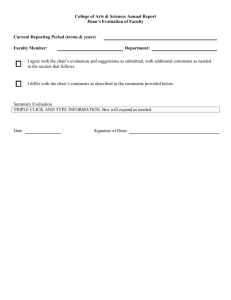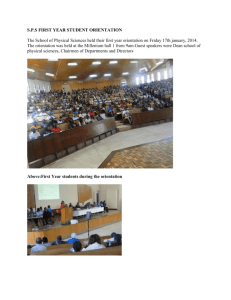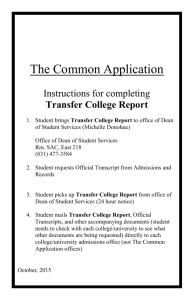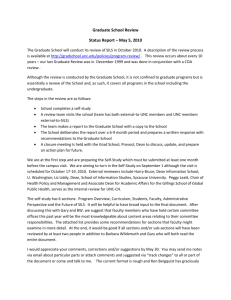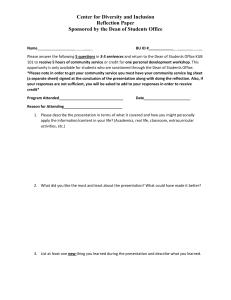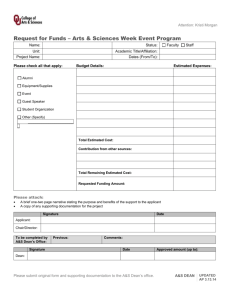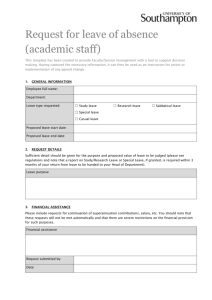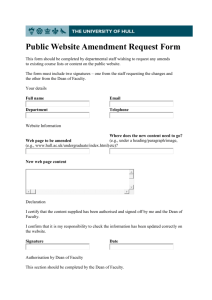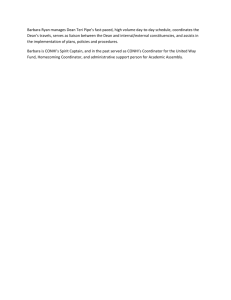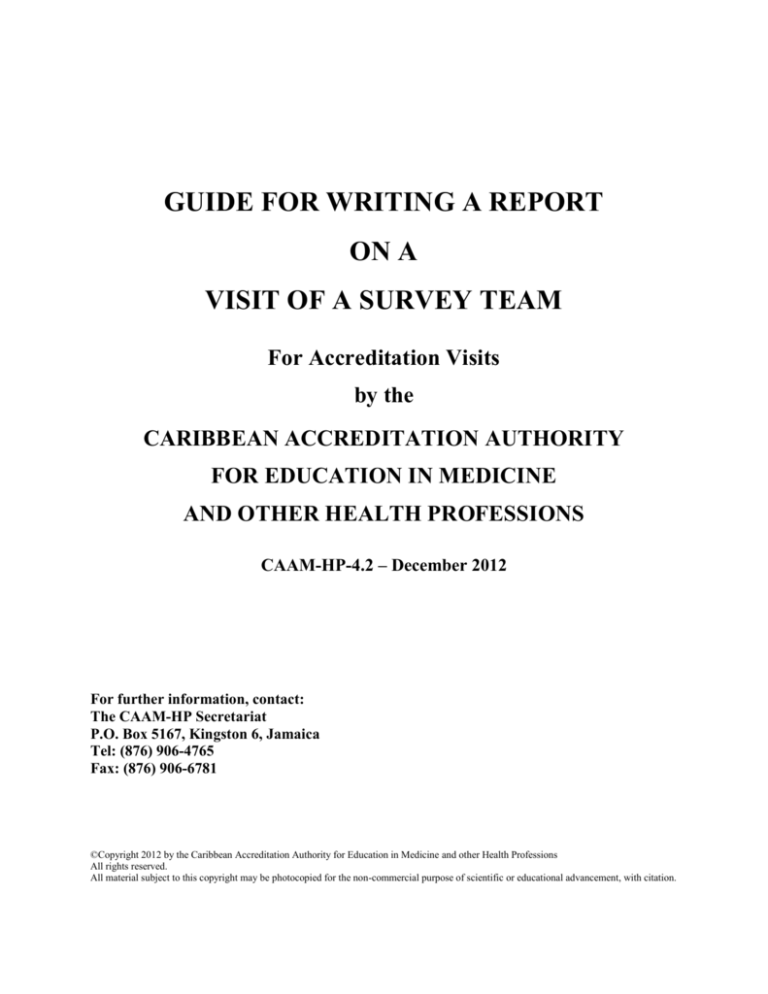
GUIDE FOR WRITING A REPORT
ON A
VISIT OF A SURVEY TEAM
For Accreditation Visits
by the
CARIBBEAN ACCREDITATION AUTHORITY
FOR EDUCATION IN MEDICINE
AND OTHER HEALTH PROFESSIONS
CAAM-HP-4.2 – December 2012
For further information, contact:
The CAAM-HP Secretariat
P.O. Box 5167, Kingston 6, Jamaica
Tel: (876) 906-4765
Fax: (876) 906-6781
©Copyright 2012 by the Caribbean Accreditation Authority for Education in Medicine and other Health Professions
All rights reserved.
All material subject to this copyright may be photocopied for the non-commercial purpose of scientific or educational advancement, with citation.
GUIDE FOR WRITING A REPORT
ON A VISIT OF A SURVEY TEAM
OF THE
CARIBBEAN ACCREDITATION AUTHORITY
FOR
EDUCATION IN MEDICINE and other Health Professions
To Survey Teams Visiting Newly Developed or Established Schools
CAAM-HP-4.2 – December 2012
For further information, contact:
The CAAM-HP Secretariat
P.O. Box 5167, Kingston 6, Jamaica
Tel: (876) 906-4765
Fax: (876) 906-6781
ii
GUIDE-FOR WRITING A SURVEY REPORT
Table of Contents
Introduction
1
Background
1
Responsibilities of the Team Secretary
2
The Report of a Full Accreditation Survey
3
The Report of a Limited Survey
22
Guide for Report Preparation
25
Sample Contents
27
Sample List of Appendices
29
Sample MEMO from the Survey Team to the CAAM-HP
30
iii
INTRODUCTION
These guidelines have two purposes:
(1)
to indicate to survey team members the areas of a school’s function, structure, and
performance that must be evaluated in the accreditation review, and
(2)
to assist a CAAM-HP team in preparing a survey report that contains sufficient factual
detail and is rendered in a style consistent with other reports that the CAAM-HP will
review. The report should provide a clear picture of the school's environment and
objectives, programme organisation, students, resources, and educational outcomes.
The survey report should contain information on all of the standards set out in the document,
Standards for Accreditation of the appropriate health profession. The strengths of the institution
should be identified; any items of non-compliance identified by the survey team must be
documented in the narrative of the report; and major changes that could affect the school's
accreditation status, recently implemented or underway, should be noted for follow-up. A clear
and concise exposition of all of these things will facilitate understanding by the members and
staff of the CAAM-HP.
This guide describes preparation of the usual report of a full accreditation survey, and the format
of the report for a limited (focussed) survey.
BACKGROUND
The school would have invested considerable effort in the preparation of the appropriate
education database and the institutional self-study. Surveyors are expected to have reviewed this
material before the visit. While on site, the team may also want to review the unabridged
self-study committee reports.
Although it is expected that schools will do a fair and accurate self-study, in some cases the
self-study may not accurately portray prevailing circumstances, or may express greater optimism
about the state of affairs than seems evident to the surveyors. Care should be exercised to
validate the education database and the basis of conclusions drawn by the self-study task force.
Some of the documents may have been completed as long as a year before the accreditation visit,
and it is important to note whether major issues have been addressed and whether any new
concerns have emerged.
These guidelines outline the minimum data and conclusions which should be included in the
report. Since each school has unique characteristics, the team secretary is encouraged to add to
this framework whatever is necessary to more fully describe the school's special character or
programmes. The CAAM-HP Secretariat is available to assist the team secretary as the draft
survey report is prepared. The secretariat should be sent a copy of the draft report (including
appendices) at the time it is distributed to team members and the dean for review and corrections.
1
RESPONSIBILITIES OF THE TEAM CHAIR AND SECRETARY
The team chair and secretary are appointed by the CAAM-HP Secretariat. The team chair who
should have had previous experience of participating in surveys, assigns tasks to individual
members of the survey team. Portions of the survey report specifically assigned to individual
team members should be completed on site or sent to the team secretary within 7-10 days of the
visit. The team secretary and the chair should encourage team members to use this guide when
preparing their individual sections. The team secretary is expected to complete the draft report
shortly (4 to 6 weeks) after the visit. The secretary is responsible for organising the
contributions from the other team members, to ensure that the overall report is coherent, logical,
and internally consistent. If important areas have been omitted from a team member's write-up, it
is the team secretary's responsibility either to contact that member for additional details, or to
supply the missing content him/herself.
This guide includes some suggested figures and tables from the education database to be
included in the report as appendices. Team members and the team’s secretary should feel free to
include additional appendix material, without unduly overloading the report.
It is useful for the team secretary to compare the body of the draft report with the set of strengths
and non-compliance issues identified by the survey team, to ensure that all areas are well
documented in the text. The team chair and secretary should edit the report to ensure that there
are no attributions to individual faculty members, administrators, or students. While the
commentary of individuals who meet with the team may be important for documentation,
specific persons arid departments should, if possible, remain anonymous.
The draft survey report should be sent for review to each member of the survey team, the
CAAM-HP Secretariat and to the dean.
The dean should specifically be asked to correct any errors of fact. The team chair and secretary
should attempt to resolve any disagreement that the dean may have with the tone or conclusions
of the report. If significant irreconcilable differences remain, the dean should be invited to write
a letter to the CAAM-HP Secretariat for inclusion with the printed report.
The secretary should ask for comments to be returned within 7 to 10 working days. The final,
corrected report (with all appendices) should be sent to the CAAM-HP Secretariat office
indicated in the team mailing. See "Guide for Typists and Secretaries on Report Preparation"
later in this document for details. Secretaries should keep in mind when the next CAAM-HP
meeting is scheduled since CAAM-HP members must receive the finished report at least two
weeks before the meeting.
2
THE REPORT OF A FULL ACCREDITATION SURVEY
COVER PAGE: Please be sure that the full name of the school and the visit date appear on the
cover page.
TABLE OF CONTENTS (including that for the Appendices): See samples at the end of this
document.
MEMORANDUM FROM THE SURVEY TEAM TO CAAM-HP: See sample at the end of
this document.
INTRODUCTION AND COMPOSITION OF THE SURVEY TEAM
A typical example:
A survey of the University of XXX School of Veterinary Medicine was conducted on
December 1-4, 2004, by a team representing the Caribbean Accreditation Authority for
Education in Medicine and other Health Professions (CAAM-HP). The team expresses
its appreciation to Dean XXXXXX and the administrative staff, faculty, and students for
their interest and candour during
the survey visit. Associate Dean XXXXXXX and
XXXXXXXX deserve special thanks for the smooth coordination of the visit, tactful
management of scheduling changes, and
timely provision of additional items of
information requested during the visit.
After the paragraph introduction, list the members of the survey team, giving their names, titles
and institutions, and their roles in the survey team as chair, secretary, member, or faculty
representative. For example:
Chair: XXXXXXXXX (Qualification)
Position and Address
Secretary: XXXXXXXX (Qualification)
Position and Address
Member:
Member:
SUMMARY OF SURVEY TEAM FINDINGS
The summary of team findings should begin with the following text:
DISCLAIMER: The summary findings that follow represent the professional judgment of the
survey team that visited the XXXX school from XXX to XXX based on the information
provided by the school and its representatives before and during the accreditation survey. The
CAAM-HP may come to differing conclusions when it reviews the team's report and any related
information.
3
Summarise the survey team's findings under the headings:
Areas of strength,
Areas of Partial or Substantial Non-compliance, and, if appropriate,
Areas of Transition.
Findings within each of these categories should be listed in the order of the sections in the
appropriate document on Standards for the Accreditation of Medical and other individual health
professions programmes.
Findings of non-compliance should use the following format:
(1) a brief phrase, in bold type, indicating the general issue involved;
(2) quotation of the standard involved; and
(3) a paragraph or two delineating the principal evidence indicating non-compliance.
An example of the desired format follows:
Financial Aid: “To the extent possible, a school should develop its own resources for
providing financial aid to students, thereby reducing their dependence upon external
sources.”
Tuition has gone up by an average of xxxxx percent in each of the past xxxx years, while
the level of institutional funding for grants and scholarships has decreased by an average
of xxxxx percent per year over that period. Student indebtedness now exceeds $ xxx,xxx
on average, with loans comprising over xx% of the student debt portfolio.
If a non-compliance issue can be linked to several standards, the team should identify that
standard which most closely reflects the underlying issue. Any related standards can be
mentioned in the body of the report.
Areas of Transition are intended to identify significant events or activities taking place which,
depending on how they turn out, could materially affect the school's accreditation status.
Examples of such events include recurring decreases in a major funding source (like government
allocations), reorganisation of the school's administrative leadership, or fundamental changes in
the structure or implementation of the educational programme.
It is essential that non-compliance and transition issues be fully documented in the body of the
report; where possible the basis for judging an item as an institutional strength should also be
adequately documented in the narrative of the report. The documentation in the body of the
report regarding non-compliance and transition issues should give a sense of relative magnitude
of the problem, indicate if it has persisted for a lengthy period, and identify any progress towards
resolution.
Prior Accreditation Survey(s) and Progress Report(s)
Summarise the key findings and recommendations of the most recent survey. If there was a
recent limited survey; summarise both this and the earlier full survey of the school. Note any
progress reports addressing problems identified previously. Give the dates of the prior survey(s)
and reports. Use bullets, paraphrasing or combine items as needed to be succinct.
4
The Education Database and Institutional Self-Study
Comment on the organisation, completeness, and internal consistency of the database. Were the
numerical data (applicant, admissions, financial, etc.) updated to the current year? Comment on
the self-study, in terms of the degree of participation by the school faculty, administrators,
students, et al; the comprehensiveness and depth of analysis; the organisation and quality of the
conclusions and recommendations; and the dissemination of the report's findings to the academic
community. Mention the degree to which the survey team's major conclusions are concordant
with those of the self-study. Comment on the methods used in the students' self-study, including
the level of student participation obtained.
History and Setting of the School
Briefly summarise the history of the parent university and school, and supply figures for
undergraduate and graduate enrollment, listing colleges and schools. Briefly describe the setting
of the school, its public or private ownership, role in the state and local community, and its
relationship with the parent university, health sciences centre, geographically separate
campuses/programmes, and principal teaching hospital(s). Give geographic relationships to cities
and other campuses and similar schools in the region.
Conclude with a table comparing selected data for the reference years used for the current and
past database. For example:
The table below compares the kind of selected data that should be used for the reference years
used in the databases compiled for the years xxxx and xxxx accreditation surveys.
Year xxxx-xx
Year xxxx-xxxx
Entering undergraduate class
Total undergraduate students
Total graduate students
Full-time basic science staff
Full-time clinical staff
Part-time basic science staff
Associate clinical staff
Total revenue
Tuition and fees
Government funding
Research/ training grants
Indirect/Professional income
Parent university allocation
($ in Millions)
Note on Organisation of the Body of the Report
The body of the report should give the team's narrative description and comments, with
references to database sections collated sequentially in the Appendix at the rear of the report.
5
This will clearly differentiate surveyor commentary from that of the institution.
Please make a reference in the narrative text to material that is included in the Appendix, e.g.,
"See charts of organisation in the Appendix," "See Appendix for membership of admissions
committee and characteristics of applicants and those entering". The Table of Contents should
show the title and page number of each Appendix document.
The team secretary should reserve original copies of hand-outs, database gages, etc. for
incorporation, as appropriate, in the final report sent to the CAAM-HP Secretariat for
reproduction. Please follow carefully the "Guide for Typists and Secretaries..." at the end of this
guidebook, especially the requirement that the type style be conventional and consistent.
The titles below are reflected in the education database and the institutional self-study.
I. OBJECTIVES
Summarise the objectives of the educational programme established by the school. (Educational
objectives are the items of knowledge, skills, behaviour, values, and attitude that are the expected
outcomes of instruction. Students should be able to exhibit these outcomes as evidence of their
achievement. Don't confuse statements of mission and goals, or vision statements about the
structure, goals, and aspirations for the university with educational objectives for students.) If the
objectives are lengthy, include them in the Appendix. If there are no outcomes-based educational
objectives, say so. Cite evidence that the objectives are understood by the school's faculty and
students, and the types of data indicating that objectives are being achieved. Comment on the
school's strategic assessment and planning (or the absence thereof) that serves as a framework for
the accomplishment of the institutional goals and objectives. Was the institutional self-study
incorporated or coordinated with the strategic planning process?
II. GOVERNANCE
Include charts of organisation in the Appendix showing relationships between Board of Trustees,
university, academic medical centre, and the school, etc.
Note whether and for how long the school or university holds national accreditation, the name of
the accrediting body, and the year of the next survey for national accreditation. Briefly describe
the composition and role of the Board of Trustees of the university or equivalent and any
committees thereof for the school. Describe the dean's role and his/her relationship to university
officials. If there is a vice president, provost, etc., for health/medical affairs to whom the dean
reports, give his/her name, a few lines about his/her credentials, and compare his/her role with
that of the dean. Identify the officer to whom the administrator of the university-owned/affiliate
hospital reports (or any other relationship characterising the teaching hospital's administrative
interfaces with the school and university authorities). Evaluate the effectiveness of these
relationships and note any problems.
6
III. ADMINISTRATION
A. Dean of the School
Include in the Appendix an organisational chart of the school and the dean's/academic head’s
curriculum vitae. Include significant publications only.
Describe in a few lines the credentials of the dean/academic head. Indicate the date of the
dean's/academic head’s appointment and describe the mechanisms of the dean’s/academic head’s
selection, appointment, and review. Comment on the stability of the dean’s/academic head’s
office and the consistency of its leadership and direction since the last full survey.
Describe briefly the dean's/academic head’s administrative style (manner of leadership;
interaction with faculty councils; and communication with other institutional officials, faculty,
and students). What is the dean's/academic head’s perception of institutional strengths, and
his/her agenda of strategic issues and directions and plans for the future?
B. Organisation of the Dean's Office
Include in the Appendix database pages showing a chart/table of the organisation of the dean's
staff and responsibilities.
Describe the organisation of the dean's office. Is the staffing adequate and the division of
responsibility reasonable, effective, and understood by the faculty and students? Do students and
the faculty perceive the dean's staff to be accessible and able to solve problems?
C. Faculty Governance; Department Chairs; Administrative Committees
Include in the Appendix database pages listing chairs, heads of departmental and
non-departmental units, and administrative committees.
Comment on the existence, currency, and effectiveness of the faculty regulations. Describe the
policy-making body(ies) of the faculty (executive faculty, faculty council/board, etc.). Judge the
effectiveness of such organisations with regard to factors such as clarity of charge, size,
representation, and relationship with the dean or other governance entities. Comment on the mix
of department heads, senior, mid-career and junior faculty in the policy-making bodies. Mention
the principal standing committees, the appropriateness of the process of appointment, and
whether there are student representatives on committees dealing with student-related matters.
Judge the effectiveness of the principal standing committees. You may describe the committees
in detail in the appropriate section of the report, e.g., curriculum committee under Management
of the Educational Programme. Are department heads appointed for a fixed period? What
mechanisms exist for periodic review of departments and chairs? Note department head
vacancies or long-standing acting/interim arrangements.
7
D. Geographically Separated Campuses
Include in the Appendix database pages summarising the arrangement, or summarise this
information in the text.
If the school operates campuses that are geographically separated, comment briefly on the
administrative relationship between the main campus and the branch(es). What mechanisms exist
to ensure functional integration and achieve comparability of educational quality and the
evaluation of the students across various sites of instruction? How well do these mechanisms
work? How is student support (academic and career counselling, financial aid administration,
health service and personal counselling, etc.) supplied at the remote campus(es)?
IV. THE STUDENTS
A. Admissions
Include in the Appendix database pages showing the membership of the admissions committee
and the qualifications, GPAs, etc. and the demographic characteristics of applicants and those
admitted.
Summarise the requirements for admission. Briefly describe the admissions process, including
the organisation and operation of the admissions committee. Does the school's catalogue provide
an accurate representation of the admissions process and criteria for selecting students? Are there
published technical standards for the admission of disabled students? Comment on the number of
national, regional and the number of non-regional applications for the most recent three-year
period, the number of offers issued in these categories, and the number of entries in these
categories. Evaluate the sufficiency of qualified applicants in relation to the number of students
who enter, and in terms of the premedical qualifications, GPAs, and any other antecedents
predicting academic success in the school. Are there any plans to increase or decrease enrollment
in the next five years?
Comment on any combined undergraduate college and the school’s education programmes,
enhancement options, accelerated programmes, combined Ph.D. programmes, and other
innovations. What are the policies for admitting transfer students? Do students admitted with
advanced standing have the same qualifications as regular students?
Determine whether the school enrolls students from other schools in clinical courses. If so, are
appropriate resources available for teaching and supervision, commensurate with the students'
abilities? Do the numbers of outside students from all sources place a significant strain on
existing resources?
B. Diversity Issues
Does the school have a policy addressing the goals for diversity of its student body in relation to
gender, ethnicity, religion etc? Describe the organisation of the school's programmes for
8
recruitment and retention of underrepresented groups. Are the school's programmes successful in
achieving satisfactory graduation rates for specially admitted students, and in reaching
institutional or governmental goals for diversity?
C. Financial Aid
Does the availability of loans and scholarships meet the needs of the school's students? Are
either costs or the availability of financial aid a deterrent to student recruitment? Cite the average
debt of indebted students. Can the school provide sufficient financial aid through its own
resources to reduce the need for students to use external sources? Comment on the organisation,
operation, and accessibility of any financial aid office or service. Comment on student
satisfaction with the system of financial aid administration.
D. Student Health Services; Personal Counselling
Describe the health services available to students, and evaluate the accessibility and cost of these
services. Is adequate health and disability insurance required/available? How are they financed?
Are students adequately screened for their immunisation status, given appropriate vaccinations,
and properly instructed about infectious disease prevention and exposure?
Describe the personal counselling services available to students, including their accessibility and
confidentiality. Summarise any programmes to promote mental well-being and facilitate
adjustment to the demands of the school. Include student input on health and personal
counselling services. Comment on the school's policies and efforts to prevent student
mistreatment.
E. Student Input
Include the students' analysis in the Appendix.
Identify and judge the significance of exceptionally positive or negative student opinions about
access to the dean's staff and faculty; participation in school committees; the curriculum and
educational experiences; the evaluation and grading system, feedback, remediation, and due
process; personal, academic and financial/debt counselling; the learning environment; the quality
of facilities for students; and the programmes for student health and student life on the campus
and affiliate sites.
V. EDUCATIONAL PROGRAMME
Include in the Appendix diagrams showing the curriculum structure for each year.
A. Duration, Design
Briefly describe in an introductory paragraph the general organisation of the curriculum for the
years of the course. How many required weeks of instruction are there in each year? Review the
9
workload of students in the pre-clinical years and evaluate the balance between passive and
active or self-directed learning opportunities. Is there sufficient unscheduled time for
independent study? Discuss the balance between in-patient and ambulatory education, and the
sufficiency of experiences in primary and specialty care. For schools with geographically
separated campuses, describe the number of students at each campus and the mechanisms for
assigning them to the various sites. Note any recent or pending changes in the organisation or
design of the curriculum.
B. Management of the Curriculum and Evaluation of Programme Effectiveness
Include in the Appendix database pages showing the composition of the curriculum committee.
Describe the system of curriculum planning, implementation, evaluation, management and
oversight. Where does the responsibility for these activities reside? Comment on the institution's
effectiveness in achieving a coherent and coordinated curriculum.
Summarise the mechanisms by which quality control is assured, including oversight of courses
and teaching quality, and avenues of student input. Does the curriculum committee receive these
data and use them to make needed changes? Evaluate the adequacy and effectiveness of these
processes. Who besides the students is thoroughly knowledgeable about the curriculum? Does
the school maintain a curriculum inventory to guide planning and correction of omissions and
unnecessary redundancies? Cite pertinent comments from the self-study and database to
document your findings and conclusions.
Cite the evidence for educational effectiveness obtained from the outcome measures that are
examined by the curriculum committee, such as student attrition rates, rates of academic progress
and graduation, measures of basic-science grounding in the clinical years, success and quality of
residency appointments/job placements of recent graduates, performance of graduates in
residencies, and performance in examinations, university or licensing, with special reference to
Standards ED-1, ED-42 and ED-43, if applicable. This information must be included in the Site
Visit Report as an Appendix. It should be noted that schools do not traditionally collect
comprehensive information in this regard except for the early stages, and these standards must be
interpreted as qualitative and as a stimulus to the collection of more objective data.
Evaluate the attainment of the school's students in relation to how well students have met the
school's internal standards. How do students rate the curriculum in the students' self-study?
C. Content and Review of Subjects Required for Accreditation, By Year
Organise the description of the programme of undergraduate education by year or academic
period, e.g. sometimes the third and fourth years are organised as a continuum.
1. First-year Courses
2. Second-year Courses
In these sections describe only the required courses.
10
For each basic science course, describe the total scheduled hours and the breakdown by
instructional method (lectures, laboratories, small-group conferences, etc.). Summarise the
course content/objectives. Evaluate the course in terms of appropriateness of assigned hours,
content and timing in the curriculum, course design and teaching methodology, explication of
objectives, evaluative techniques (kinds and sequencing of examinations), the accomplishment of
desired educational outcomes (document them), and the adequacy of resources to support
education. What is the balance between didactic instruction and interactive, small-group,
problem-based, and/or self-directed teaching/learning? Is computer-assisted learning employed?
What is the evidence that students acquire self-directed learning skills and use data in realistic
problem-solving?
In thinking about student evaluation, consider what internal and external measures are used to
evaluate students. Are there mid-point evaluations to identify students in trouble, with timely
counselling and remediation? What is the mix of formative and summative evaluations? How are
student grades determined? Do students receive prompt feedback on tests of their performance?
Cite measures of educational effectiveness, such as student ratings (from the students'
self-study), and draw a conclusion about course effectiveness. An example of the write-up of a
traditional basic course follows:
Biochemistry. Biochemistry is a XXX-hour course in the first-year, XX hours of lectures
and XX hours of conferences. It is appropriately located in the curriculum. The major
objectives of the course are for students to understand the interplay between structure
and function at a molecular level, basic concepts of enzyme kinetics and allosteric
regulation, and current concepts regarding metabolic pathways at the cellular and subcellular levels. Exam performance is the main determinant of the achievement of
objectives. A curricular review two years ago led to a decrease in course content and
lectures in favour of small-group, problem-solving. Faculty members attempt to be
facilitators rather than content experts in these sessions, and make themselves available
informally at other times for consultation with students. In some lectures, team-teaching
is done, pairing basic science and clinical faculty for discussions of disease mechanisms.
There is one mid-term and one final examination; each counts for half of the final grade.
Considerable care is taken in the preparation of examinations, which feature
short-answer and essay questions. Computer-based self-testing is available for students
to measure their progress in learning course material. The course is highly rated by
students and faculty for overall organisation, excellence of its syllabus, and quality of
lectures and small-group exercises.
An example of an interdisciplinary course write-up is given below:
Structure and Function. This XX-week structure-function course spans the mornings of
the entire first year and integrates biochemistry, cell and molecular biology, physiology,
gross anatomy, history, and neuroscience. The curriculum includes cellular function (X
weeks), introduction to the human body (X weeks), cardiovascular/respiratory/renal unit
(X weeks), gastrointestinal unit (X weeks), reproductive/endocrine unit (X weeks),
11
musculo-skeletal unit (X), head and neck unit (X), and neuroscience (X weeks). The
format consists of XX hours of lectures, XX labs in histology, XX labs in gross anatomy,
X neuro-anatomy labs, X computer labs, and XX problem-based learning sessions. There
is strong emphasis on interactive learning methods.
The objectives of the course as a whole are to "integrate all basic science disciplines" to
provide an orientation to fundamentals of cell biology prior to the organ-systems course
in the second year known as Systematic Basis of Medicine. There is a detailed syllabus
for each section of the course, in which most of the instructional objectives are expressed
as items of knowledge to be taught or learned.
Students are evaluated by xxx computer-graded multiple choice examinations and xxx
practical examinations in histology and anatomy. Performance in the problem-based
learning sessions is evaluated by the conference tutor; the narrative results are not
included in the grade, but forwarded to the student affairs dean for inclusion when the
dean's letter is written. Grades are based xx% on multiple-choice examinations and xx%
on the practicals. The course is evaluated by meetings with student representatives and
year-end reports. 1n their self-study, students say that PBL is a successful component of
the curriculum and an enjoyable and effective way to integrate learning and
understanding. Seventy percent of students are satisfied with the course.
For the introductory clinical courses and which teach history taking, physical examination,
patient work-up and presentation, and related subjects, evaluate the adequacy of instruction and
evaluation. Are students observed performing patient histories and physical examinations? Are
adequate supervision and feedback provided? Is the patient base adequate? Are patient or
computer simulations used? How are faculty preceptors vetted for their own competencies in
history-taking and physical examination?
3. Third-Fourth-year Courses
In discussing the required core clerkships/clinical experiences, introduce each with a description
of duration and locations and a breakdown of clerkship/clinical experience with respect to
inpatient vs. outpatient experiences, and hours of case conferences and didactic sessions for
students. Are there explicit learning objectives for each clerkship/clinical experience? Are
juniors involved in supervision and teaching, and are they instructed about the specific
educational objectives to be achieved, and advised on how to evaluate students? Do faculty
provide adequate supervision and teaching?
Summarise the number of patients worked up weekly in each clerkship/clinical and ambulatory
experience, and methods for assuring that students see an appropriate mix of patients. If
clerkships/clinical experiences in a given discipline are conducted in several hospitals or clinical
sites, what efforts are made to ensure that there is equivalency in educational quality of the
experiences and the evaluation of students? Do students gain experience in community settings?
How is the clinical performance of students evaluated? Do clerkships/clinical experiences
comply with the accreditation standard requiring structured observation of students'
12
history-taking, physical examination, and relationships with patients? Do students receive
mid-course evaluation and feedback? How are grades assigned? Do students receive prompt
feedback about their performance at the end of the clerkship/clinical experience?
How do students evaluate the quality of their experience in each clerkship/clinical experience?
Conclude with a judgment about the effectiveness of the clerkship/clinical experience in meeting
its objectives and preparing students for graduate training. Buttress conclusions by citing
students' opinions about the quality of teaching and their experiences.
An example of the write-up of a surgery clerkship is shown below:
Surgery. The xxxxx-week Surgery clerkship takes place in xxxxx affiliated hospitals.
There is high consistency in the mix of conferences and patient experience and in the
number of new and follow-up patients assigned (x new patients per week; xx followed).
Students obtain ambulatory experience as they see their consultant’s patients in the clinic
before and after scheduled hospitalisation. Students’ final grades are based xx% on an
internally-written examination, xx% on a structured bedside examination of clinical
skills, and xx% on ratings by junior and associate and faculty. Students give high praise
to their Surgery experiences and take a large number of electives in the field.
Management of the clerkship is outstanding. Coordination and quality assurance are in
the hands of a xxxx-time educational coordinator. Clerkships are arranged so that no
more than x students are present at small group activities such as in the out-patient
setting and bed-side ward rounds. Multiple dimensions of the clerkship are compared for
each hospital on the basis of student evaluations (a xx-item self-administered
questionnaire) and exit debriefings. Good and poor staff and faculty are reported to the
clerkship coordinator. The department has a remediation programme designed for
students in difficulty, based on a diagnostic programme and customised examinations
and observations. The department has workshops to foster teaching skills of the faculty.
The survey team commends the head of the department for his extraordinary initiatives in
undergraduate education.
4. Electives
Summarise the nature and quantity of electives taken by students, including how much elective
time is available, when and where it occurs, and the level of faculty and student satisfaction with
the opportunities available and taken. What are the counselling and control mechanisms to assure
course quality, to integrate elective choice with career planning, and to limit duplication of
off-campus electives? How do students rate the electives programme?
D. Summary
Finally, summarise the team's evaluation of the curriculum, listing specific strengths,
deficiencies, problem areas, and opportunities for improvement. State if all subject areas required
in accreditation standards (e.g., behavioural and socio-economic subjects, preventive,
rehabilitative, and end-of-life care, ethics) covered adequately? Evaluate the adequacy of
13
educational experiences relating to social and cultural circumstances that affect patient health,
including domestic violence or abuse, and the effects of differing cultures and belief systems on
health care delivery. Has the school laid out its objectives for clinical education and defined the
necessary educational settings, the roles for students, and the number, disease mix, and severity
of patients or patient and computer simulations to accomplish the stated purposes?
E. Evaluation of Student Achievement; Due Process
Describe the composition and role of the promotions committee(s). Are the school's standards
and procedures for student evaluation, advancement, graduation; disciplinary action, appeal, and
dismissal clearly stated, adequately published, and widely understood by students, faculty
members and administrators? Are there clearly understood procedures to assure due process, i.e.,
timely notice of a disciplinary charge or an adverse academic action and an opportunity for fair
and impartial hearing? Describe the system for ensuring confidentiality of student records and
their availability for review by the student.
Does the school employ a variety of measures of student performance appropriate to its
educational objectives? Is there formal evaluation of problem-solving and clinical reasoning
ability? What is the mix of formative and summative evaluation? Are examinations coordinated
between courses? In general, are students given formal mid-course and mid-clerkship/clinical
experience feedback? Are there any mechanisms for independent evaluation of the students by
external examiners? If so describe the teaching experience and qualifications of the externals and
append their reports.
Briefly describe the grading system and evaluate the consistency of its application across
disciplines and individual students. Comment on the use of narrative descriptions of student
performance and of non-cognitive achievement.
In this section, also include comments from the students' self-study on the effectiveness of
procedures for student evaluation, timeliness of feedback, advancement, graduation, disciplinary
action, remediation, and appeal.
F. Academic Counselling and Career Guidance
Include the tables of student attrition and academic difficulty, and a sample of a student’s
transcript in the Appendix.
Summarise the methods of orientation of incoming students, early warning system for academic
difficulty, and system of academic counselling, tutoring and remediation. Discuss the attrition
rate and the proportion of students on leave of absence. Is there a pre- or post-matriculation
tutorial/counselling programme for students at high academic risk?
Are opportunities for deceleration available? Evaluate the effectiveness of academic counselling
and support programmes, citing documentation from student input. Evaluate the system of
counselling students on career choice and residency/graduate applications.
14
Describe the process of developing the student transcript and its value in relation to the success
of students in obtaining their choice of residency/graduate programme. Comment on the school’s
record in regard to meeting the manpower and specialty needs of the country and region, or other
stated school specific goals.
VI. RESOURCES FOR THE EDUCATIONAL PROGRAMME
A. Finances
Include in the Appendix pages from the database showing the revenue and expenditure summary
for the duration of the programme.
Use a table like the following to describe the breakdown of revenue sources.
Revenue Sources
($ in Millions)
Source
Tuition and fees
Government appropriation
University
Grants & contracts
Indirect cost recoveries
Gifts and endowments
Other revenues
Total revenue
Year xxxx-xxxx
Percentage of Revenues
Briefly describe the trends in revenue sources and expenditures over the past several years, and
describe the current and projected fiscal condition of the school. Identify any major discrepancies
that may now or in the future create problems. If there is a current or potential fiscal imbalance,
does the school have a credible plan to address it? Are the school's educational programmes
suffering or endangered by under-financing or by distortion of the school's efforts and priorities
necessary to balance the budget?
Briefly discuss trends in charges for tuition and fees, how these are determined, any plans for
further increases, and whether escalation of educational costs is having an adverse effect on
applicants and the enrollment of students.
Describe the structure linking the principal hospital(s), the related healthcare system, any faculty
practice plan, and clinical faculty/hospital staff, showing the degree of integration,
multi-specialty group-practice, contracting authority, and arrangements with insurers, etc. What
is the condition of the healthcare system and the strength of the school's position in that system?
Conclude with a statement about the school's financial status and prospects.
15
B. General Facilities
Include summary pages from the database in Appendix xx.
Make brief comments about the age, size, appearance and quality of the school's general facilities
including hospitals. Is available space for teaching and research adequate for the number of
students, the number of existing and needed faculty and for the current or desired curriculum
structure? For anticipated research expansion? Comment on whether space for faculty, research
and education activities is organised to advantage, i.e., distributed vs. consolidated. If new
construction is planned or underway, describe the proposed new facility(ies), indicating sources
of funding and expected completion date(s).
C. Faculty
Include in the Appendix summary database tables showing numbers of basic science and clinical
faculty and faculty salaries and benefits, compared with the incomes in the country and region
for similar jobs.
Summarise the size of the basic-science and clinical faculty and note the trend since any previous
survey. Comment on the adequacy of the faculty size for the school's teaching, research and
patient care missions. Does the school have specific policies or goals regarding faculty diversity,
and if so, how well are such goals being achieved? How does faculty compensation compare
with regional and international norms for basic-science and clinical departments? Do faculty
members have sufficient input into organisational decision-making, through the committee
structure or directly? Comment on the opportunities for communication among faculty members
and on activities that promote collegiality. Evaluate the procedures and criteria for faculty
appointment, standing, promotion, and tenure. How effective is the system for mentoring faculty,
including encouraging professional development and scholarly activity? Does the clinical faculty
show evidence of continuing scholarly productivity? Is organised support available to assist
faculty to develop teaching skills and instructional materials? Is the faculty knowledgeable about
current trends in pedagogy, curricular design to accomplish educational objectives, and methods
of measuring student performance? How does the school assure that part-time and volunteer
faculty possess the required skills to teach and evaluate students?
D. Library/Information Services
Include database pages on the library and information systems in the Appendix.
Evaluate the adequacy of the library's hours, services, holdings, staff, and facilities. Does it meet
the needs of the faculty and students? Is there adequate study and small-group conference space?
What is the quality of the library's automated databases and bibliographic search, computer and
audiovisual capabilities? Is the library adequately funded? Is there an effective mechanism to
ensure faculty and student input to school/university administration on matters of library policy
and procedures?
Evaluate the school's use of computer-assisted learning, particularly as an integral part of course
16
instruction. Comment on the availability and accessibility of hardware and software, and on the
faculty's interest and ability to use it. Is computer-assisted instruction substituting for more
traditional teaching and/or assessment of students? Is it cultivating self-learning behaviours? Are
there resources to help the faculty identify or develop educational material?
E. Clinical Teaching Facilities
Include summary database pages on each of the major affiliated hospitals and on the organisation
of community/ambulatory facilities for clinical education. These should show hospital
characteristics and the distribution of students and residents.
Describe in serial paragraphs the hospitals and ambulatory-care facilities utilised for clinical
experiences. For facilities visited by the survey team, evaluate quality, the general level of
patient-care activity, and the amenities for students (conference and classrooms, on-call quarters,
library, etc.). Look at sample history-physical examination records and progress notes and
comment on evidence of supervision and review by faculty and/or residents.
Provide a summary description of the network of teaching facilities and comment on the overall
quality and the collective sufficiency of experiences necessary for the clinical education of the
students. Treat especially the outpatient teaching facilities, noting the adequacy of consultation
space, appointment and information systems, etc.
Are written affiliation agreements up to date and explicit on the role of and expectations for the
students? Are the clinical service chiefs appointed by or with the concurrence of the school? In
clinical affiliations, does the school faculty have control and authority for the educational
programme? Are there any problems intrinsic to the clinical facilities themselves, in the
relationship of the school with affiliated hospitals, or from the impact of the student teaching
programme on teaching hospital operation or funding? Are there adverse clinical teaching
impacts relating to declining hospital utilisation, shorter length of stay, increased patient acuity,
and/or changed case mix? Do the clinical facilities provide adequate space and amenities,
sufficient opportunity to work up and follow patients, freedom from excessive service work, and
an acknowledged priority of teaching? Summarise the adequacy of student supervision by
residents or attending physicians, dentists or veterinarians, faculty or clinical instructor. Mention
any clinical services without approved junior staff training programmes. What is the availability
and perceived teaching effectiveness of faculty?
VII. INTERNSHIP (where applicable)
Include in the Appendix the document showing the structure of the internship and the approved
post and sites.
Describe the composition of the committee responsible for approving and monitoring the
internship as well as the criteria used to ensure that the interns get sufficient supervision, enough
time for academic reading and relaxation. Comment on how supervisors are chosen and how
assessments are made and monitored.
17
What is the process whereby unsatisfactory performance is determined, the intern informed and
remedial action taken? What process is in place for an intern deemed to have performed
unsatisfactorily to have their case independently reviewed?
Comment of the interns views on their terms of remuneration, work hours, supervision and
assistance/counselling re graduate careers.
VIII. GRADUATE EDUCATION
Include in the Appendix summary pages showing numbers of graduate trainees, residency
programmes and sponsoring programme.
Describe the existing graduate and/or residency programmes, including total enrollment and
degrees awarded. Are the graduate programmes under the auspices of the university's graduate
school, the medical, dental, veterinary or nursing school, a graduate council, or individual
departments? Describe the graduate faculty. Does the institution conduct a regular and
systematic review of the graduate programme, evaluating research productivity, the strength of
the faculty, accomplishment of trainees, and the role of the graduate programme in the education
of the students? Evaluate the appropriateness of size, jurisdiction, adequacy of funding, and the
value of the graduate programme to research and education in the medical, dental, veterinary or
nursing school. If graduate students participate in student teaching, are they prepared for their
teaching role?
IX. RESEARCH
Summarise the number of basic science and clinical faculty members who are principal
investigators and the number and dollar value of both institutional and extramural research
grants. Evaluate the trend in research funding over the past three years and indicate the extent to
which research is an institutional priority. Is there an appropriate infrastructure to support
research? Is there an explicit strategy to pursue specific research directions or accomplish a
particular level of research productivity? Are there departmental or individual research
incentives? How broad is the research involvement of basic science and clinical departments?
Are there "centres of excellence" and/or interdisciplinary research institutes on the campus or
affiliated with the institution? To what extent do the students participate in research?
X. CONTINUING PROFESSIONAL EDUCATION
Comment on the scope of the programme and the involvement of the faculty in meeting the
continuing education needs of the professional community served by the school. What is the
impact, if any, of CPE on the undergraduate education programme?
18
XI. DEPARTMENTS
Include in the Appendix the summary basic science and clinical department tables from the
database.
A. Basic Science Departments
Include the basic science departments with a major role in student teaching. In a brief preface,
evaluate the basic science departments collectively, in relation to their overall sense of mission
and philosophy, resources (financial, faculty, facilities), academic strength, and cohesion in
teaching and research.
Use tables like the following to summarise the following relationships and cut down on
repetition in the narrative.
Basic Science Faculty Numbers and Percent Time Teaching the Students
Department
Total
Faculty
Full-time
Faculty
Percent time
Teaching
Percent time
Research
Cell and Mol Biology
Microbiol-Immunology
Mol Pharmacology
Pathology
Physiology
Basic Science Department Expenditures, 1995-96, By Funding Source ($ in Millions)
Department
Govt. /School
Funds
Research,
Training
Department
Sources
Total
Expenditures
Cell and Mol Biol
Microbiol-Irnmun
Mol Pharmacol
Pathology
Physiology
Through the use of such tables and narrative, cover the following in a description of each
department: the adequacy of its faculty size, space, equipment and financial resources, and its
proportion of time spent in student teaching, research and other activities. Comment on the
proportion of financing from university/state sources, -grants and contracts, and other income.
Note any successes or problems with graduate training programme. Summarise departmental
faculty development activities and mentoring programme. Express the survey team's judgement
of any major areas of strength or weakness (non-compliance, partial compliance or substantial
non-compliance) in the department's educational activities, research productivity, and other
missions and responsibilities.
A write-up of a basic science department should read something like this:
Biochemistry. A new chair was appointed six months ago. The department has been
successful in recruiting faculty and obtaining research support; but this now is limited by
19
available space. Approximately xx% of faculty time is devoted to research: Strong areas
of research include molecular biology, protein structure, and trans membrane signalling.
Faculty members are well represented on national committees and study sections, and
published xx papers and x books and chapters last year. xxx students are presently
enrolled in the Ph.D. programme. All incoming junior faculty are paired with a senior
faculty mentor during their first year.
The department has an excellent record of innovative teaching and has a first-class
course director. It is well positioned for the future, and it is anticipated that it will grow
under its new leadership.
B. Clinical Departments
Include the clinical departments with major roles in student teaching. Prepare this section the
same as the Basic Science Departments above. Use tables to summarise key features and to avoid
repetition of data in the narrative, but, through tables and narrative, cover the same points as with
the basic science departments. In addition, comment on the impact, if any, of pressure for clinical
service on teaching commitments, and on the dependency on and prospects for clinical income.
Where appropriate, comment on the number and quality of applicants for residency/graduate
training and the extent to which the programmes are filled. Describe any departmental
programme for preparing residents for their roles in teaching and evaluating students.
Clinical Faculty Numbers and Percent Time Teaching Students e.g Medical School
Department
Total
Faculty
Full-Time
Faculty
Volunteer
Faculty
% Time Teaching
Students
Family Medicine
Internal Medicine
Neurology
Obs/Gynaecology
Paediatrics
Psychiatry
Surgery
Clinical Department Expenditures, 1995-96, By Funding Source* ($ in Millions)
e.g Medical school
Department
Govt./School Funds
Research,
Training
Other Dept.
Sources
Total
Expenditures
Fam Medicine
Int Medicine
Neurology
Obs/Gynaecology
Paediatrics
Psychiatry
Surgery
An example of a write-up for a clinical department is given below:
20
Surgery. The chair was appointed to that position one year ago. The teaching of students
accounts for xx% and the teaching of house staff for xx% of faculty effort; research
occupies xx% of the faculty's time. Areas of research emphasis include transplant
immunobiology and immunotherapy, the biology of wound-healing and metabolism in
critical illness. In the last year, faculty members published xx papers and x books or
chapters. Faculty mentoring is provided by the chair on an informal basis. The
department sponsors a "Teaching the teachers" programme annually for its faculty and
residents.
There are no undue pressures to generate clinical income, and commitments to clinical
activities have not distorted the department's teaching or research missions. The
department is well-endowed with faculty, and readily staffs new programme and replaces
those who retire or leave through its internationally-acclaimed residency and
postdoctoral training programme.
21
THE REPORT OF A LIMITED SURVEY
Introduction
An interim, limited survey is conducted when concerns of a serious nature arise and the CAAMHP believes that a site visit is necessary to validate the corrective actions. In general, the team
conducting a limited survey should focus on these specific areas of concern during the visit.
However, any substantive new problems that have emerged in the interim may also be pursued
by the team.
Background
In preparation for the limited survey, the school is sent a letter by the CAAM-HP Secretariat six
months beforehand detailing the elements of a "mini-database" that will provide the descriptive
and quantified information about the concerns of the CAAM-HP. This database is used to
provide supporting documentation for the text and appendices of the limited survey report. The
survey team chair and secretary are expected to review carefully the school's previous
accreditation history (survey and progress reports). They should organise the visit and
discussions around the items of concern highlighted in the letter to the school outlining the areas
to be documented in the database.
Limited Survey Report Format
Cover page. Please be sure that the full name of the school and the visit date appear on the
cover page.
Table of contents. Organise by category of concern, listed in the order that the items would
appear in the full-survey database (e.g., Objectives, Governance/Administration, Educational
programme, The Students, Resources, etc.). Include a table of contents for the Appendices, as
well.
Memorandum from ad hoc survey team to CAAM-HP. As with a full report.
Brief introduction. As with full report.
Composition of survey team. As with full report.
Summary of Findings and Conclusions
This is different from the list of institutional strengths, non-compliance issues, and transition
areas of the regular, full report. This summary is a listing of the issues addressed by the limited
survey, including any new concerns explored during the survey, arranged in the same order as
the sections come up in the regular database (see Table of Contents, above). It describes the
team's findings on each concern separately in summary terms (the details of the problem and the
findings come later). An example of summary statements in a limited survey follows (items in
brackets are used to show order of citation by denoting sections in for example Standards for
22
Accreditation of Veterinary Schools in the Caribbean Community (CARICOM)
Summary Findings and Conclusions, for example:
Educational Programme
The previous barrier to curricular renewal has been eliminated as the dean has appointed a new
curriculum committee and the Faculty Council has adopted new bylaws to empower it with
responsibility for implementation and management of changes agreed to by the Council.
The Students
The school has made no appreciable progress in the administration of student financial aid. The
hours of business of the university's centrally-administered office are not convenient to the
students; the number of lost applications continues to be high; and delays in processing
applications, distributing checks, and handling problems continue unabated."
Prior Accreditation Surveys
The CAAM-HP does not always review the previous full survey report in its entirety when
considering a limited survey. Therefore, this section should contain enough relevant information
about the history and setting of the school to serve as a frame of reference.
Summarise the findings and conclusions of the previous full survey (and any interim limited
survey), quoting or paraphrasing the major strengths and concerns identified by earlier observers.
Describe the actions of the CAAM-HP, including requests for progress reports and the nature (in
summary terms) of the response(s).
Survey Findings and Conclusions
Address each area of concern separately. Related concerns can be grouped together. For each
concern, first describe the situation at the time of the previous survey visit, providing enough
supporting data firm the previous survey report to document its seriousness. Indicate whether the
problem is long-standing or has arisen recently.
Describe in specific terms the steps that have been taken to correct the concern. Provide evidence
showing how well the problem has been addressed. Indicate any further actions needed or future
plans related to the concern. Provide a team evaluation of the success in dealing with the issue.
If any substantive new concern is identified during the limited survey, describe it and provide the
team's assessment of needed corrective actions) and/or follow-up, and what, if anything, the
institution is planning to do about the matter.
Examples of the more detailed exposition of concerns follow below, based on the items in the
summary above:
23
Oversight and management of the curriculum. The previous survey showed that
curricular reform, endorsed in general terms by the Faculty Council several years
previously, had not been implemented. The student self-study was extremely critical of the
lecture-driven curriculum in the first two years and the virtual absence of opportunities
for independent- and group learning. The curriculum committee was meeting on a
quarterly basis, largely concerned with the review of new course offerings. There was no
staff support bringing critiques and plans to the attention of the committee, and no
inventory of the curriculum to identify unnecessary redundancy and opportunity for
innovation.
Since the last visit, the dean has appointed a new curriculum committee and staffed it
with a newly recruited associate dean from the McMillan University School of Veterinary
Medicine. A curriculum inventory is being built, using input from the student note service
and a key words/phrases check list completed by students in classes. The Faculty Council
has adopted changes in the faculty bylaws empowering the curriculum committee with
greater responsibility for curriculum management and implementation. The committee is
meeting every other week and expects to have a slate of first-phase curricular changes
ready for review by the Faculty Council in the next month. The faculty will be asked to
agree with a goal of 25% reduction in didactic teaching in the coming year. The survey
team finds this a commendable new beginning that will need to be followed closely.
24
GUIDE FOR TYPISTS AND SECRETARIES ON REPORT PREPARATION
General Comments
1. Use one-inch margins throughout to facilitate two-sided printing.
2. Use conventional type styles (fonts) similar to that used with official correspondence or legal
documents. Do not use large styles or all capitals. (For example, Times New Roman 12 point
is a good choice.)
3. Please carefully check the quality of all photocopying as copying may produce distortions,
low contrast, or crooked pages. Be sure that originals are of high resolution for quality
reproduction.
4. After the entire report is completed and assembled, put page number in the bottom centre of
each page, including database pages and appendices. Do not number each section separately.
5. Please use common style conventions:
The word "dean" is not capitalised except when it begins a sentence or stands as "Dean
(Name)". The same is true for vice chancellor, vice president, president, and chair.
The words "survey team" are not capitalised.
The words for example "veterinary school", "college", and "university" are not
capitalised unless they begin sentences or stand as "xxxxxxxx Veterinary School".
The word "faculty" is not capitalised unless it begins a sentence or is the equivalent of
school, e.g., "the dean intends to allocate more funds to the Faculty for laboratory
construction".
"Physiology", "Biochemistry", etc. are capitalised when they refer to departments. Note
that "department" is not capitalised unless it is "Department of Medicine".
Typing and Format
1. Please be sure that the full name of the school and the visit date appear on the cover page.
2. Immediately following the title page is the Table of Contents (including that for the
Appendix) which can be numbered with small Roman numerals in the bottom centre of the
page. (See sample.)
3. Following the Table of Contents (including that for the Appendix) is the team's covering
memorandum and signature sheet. (See sample attached.) Number with Roman numerals.
4. Signatures need not be collected now. The CAAM-HP Secretariat will route the signature
sheet to members of the survey team after the report is printed and reviewed by the CAAMHP.
5. The draft report is sent concurrently to team members, the dean, and the CAAM-HP
Secretariat; it should be a full copy, including the Appendix pages.
25
6. Please correct the majority of typographical, grammatical, and punctuation errors in the draft.
Otherwise, the reader cannot be sure they have been noted and will spend time doing editorial
correcting.
26
TABLE OF CONTENTS (SAMPLE)
Page
COVERING MEMORANDUM FROM SURVEY TEAM TO CAAM-HP
INTRODUCTION AND COMPOSITION OF SURVEY TEAM
SUMMARY OF SURVEY TEAM FINDINGS
PRIOR ACCREDITATION SURVEY(S), (DATE-----------), AND
PROGRESS REPORT(S), (DATE---------)
EDUCATION DATABASE AND INSTITUTIONAL SELF-STUDY
HISTORY AND SETTING OF THE SCHOOL
I.
OBJECTIVES
II.
GOVERNANCE
III.
ADMINISTRATION
A.
Dean
B.
Organisation of the Dean’s Office
C.
Faculty Governance; Department Heads; Administrative Committees
D.
Geographically Separated Campuses (if applicable)
IV.
THE STUDENTS
A.
Admissions
B.
Diversity Issues
C.
Financial Aid
D.
Student Health Services; Personal Counselling
E.
Student Input
V.
EDUCATIONAL PROGRAMME FOR THE M.D. DEGREE
A.
Duration, Design
B.
Management of the Curriculum and Evaluation of programme effectiveness
C.
Content and Review of Subjects Required for Accreditation, by Year
1.
First-year courses
2.
Second-year courses
3.
Third/Fourth/Fifth-year courses
4.
Electives
D.
Summary
E.
Evaluation of Student Achievement; Due Process
F.
Academic Counselling and Career Guidance
27
VI.
RESOURCES FOR THE EDUCATIONAL PROGRAMME
A.
Finances
B.
General Facilities
C.
Faculty
D.
Library/Information Services
E.
Clinical Teaching Facilities
VII.
INTERNSHIP
VIII.
GRADUATE EDUCATION
IX.
RESEARCH
X.
CONTINUING PROFESSIONAL EDUCATION
XI.
DEPARTMENTS
A.
Principal Basic Science Departments
B.
Principal Clinical Departments
28
APPENDICES (SAMPLE)
Page
Schedule of the Visit
Organisational Charts (Name) University and (Name) College
Curriculum Vitae, Dean (Name)
Organisational Chart for the Office of the Dean
Department Chairs, Administrative Units, Major Permanent Committees
Locations of Geographically Separated Campuses or Instructional Sites
Curricular Diagram, Detail
Curriculum Committee Membership
Promotions Committee Membership
Sample Dean's Letter
Admissions Committee
Background and Credentials, Applicants, Entrants
Student Analysis
Financial Exhibits
General Facilities
Faculty Numbers and Salaries
Library and Information Services
Clinical Teaching Facilities and Settings
Graduate Medical Education
Self-study Steering Committee or Task Force
Self-study Summary Findings (Strengths and Concerns)
29
MEMORANDUM (SAMPLE)
TO:
The Caribbean Accreditation Authority for Education in Medicine and other
Health Professions
FROM:
The Survey Team That Visited (name of school) on (dates)
RE:
Final Team Survey Report
On behalf of the ad hoc CAAM-HP survey team that visited the (name of school) on (dates), the
following final report of the team's findings and conclusions is provided.
Respectfully,
(Name), Secretary
30

